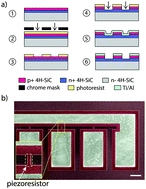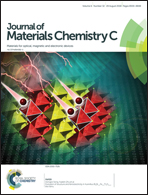High-temperature tolerance of the piezoresistive effect in p-4H-SiC for harsh environment sensing†
Abstract
4H-silicon carbide based sensors are promising candidates for replacing prevalent silicon-based counterparts in harsh environments owing to their superior chemical inertness, high stability and reliability. However, the wafer cost and the difficulty in obtaining an ohmic contact in the metallization process hinders the use of this SiC polytype for practical sensing applications. This article presents the high-temperature tolerance of a p-type 4H-SiC piezoresistor at elevated temperatures up to 600 °C. A good ohmic contact was formed by the metallisation process using titanium and aluminium annealed at 1000 °C. The leakage current at high temperatures was measured to be negligible thanks to a robust p–n junction. Owing to the superior physical properties of the bulk 4H-SiC material, a high gauge factor of 23 was obtained at 600 °C. The piezoresistive effect also exhibits good linearity and high stability at high temperatures. The results demonstrate the capability of p-type 4H-SiC for the development of highly sensitive sensors for hostile environments.



 Please wait while we load your content...
Please wait while we load your content...
